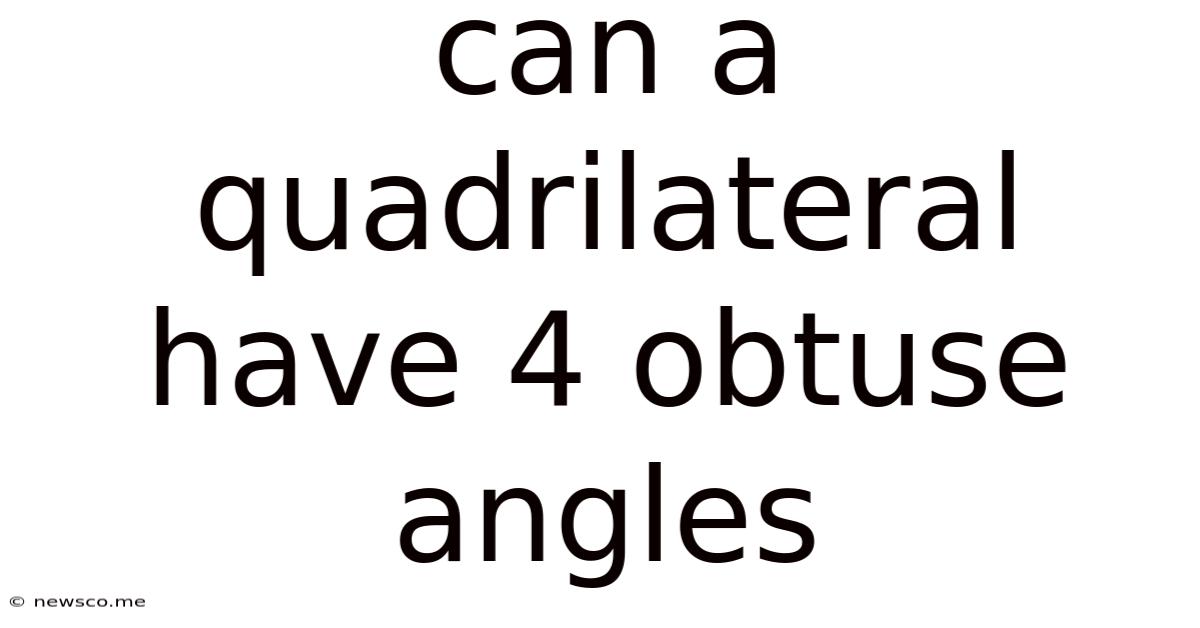Can A Quadrilateral Have 4 Obtuse Angles
News Co
Apr 24, 2025 · 5 min read

Table of Contents
Can a Quadrilateral Have 4 Obtuse Angles? Exploring the Geometry of Quadrilaterals
The question of whether a quadrilateral can possess four obtuse angles is a fascinating exploration into the world of geometry. Intuitively, it might seem impossible. After all, obtuse angles, by definition, measure greater than 90 degrees but less than 180 degrees. With four such angles, wouldn't the total angle sum exceed the known sum of angles in a quadrilateral? Let's delve into the intricacies of quadrilateral geometry to unravel this intriguing puzzle.
Understanding Quadrilaterals and Their Properties
Before tackling the central question, let's establish a solid foundation by reviewing the fundamental properties of quadrilaterals. A quadrilateral is simply a polygon with four sides, four vertices (corners), and four interior angles. Several types of quadrilaterals exist, each with its own unique characteristics. These include:
- Trapezoids: Quadrilaterals with at least one pair of parallel sides.
- Parallelograms: Quadrilaterals with two pairs of parallel sides. Special cases of parallelograms include rectangles, rhombuses, and squares.
- Rectangles: Parallelograms with four right angles.
- Rhombuses: Parallelograms with four congruent sides.
- Squares: Parallelograms with four congruent sides and four right angles.
- Kites: Quadrilaterals with two pairs of adjacent congruent sides.
Each of these quadrilateral types obeys specific rules regarding their angles and side lengths. However, the fundamental property that applies to all quadrilaterals is the sum of their interior angles.
The Sum of Interior Angles in a Quadrilateral
A crucial theorem in geometry states that the sum of the interior angles of any quadrilateral is always 360 degrees. This theorem forms the bedrock of our investigation into the possibility of a quadrilateral with four obtuse angles. Let's use this theorem to systematically analyze the problem.
The Impossibility of Four Obtuse Angles in a Quadrilateral
Now, let's directly address the core question: can a quadrilateral have four obtuse angles? The answer is a resounding no. Here's why:
If a quadrilateral had four obtuse angles, each angle would measure greater than 90 degrees. Let's represent the four angles as A, B, C, and D. Mathematically, we can express this as:
- A > 90°
- B > 90°
- C > 90°
- D > 90°
Adding these inequalities together, we get:
A + B + C + D > 360°
This inequality directly contradicts the fundamental theorem that the sum of the interior angles in any quadrilateral must equal 360°. Since the sum of the angles would exceed 360°, it's impossible for a quadrilateral to have four obtuse angles. The angles simply cannot simultaneously fit together to form a closed shape.
Visualizing the Problem
Imagine trying to construct such a quadrilateral. As you draw each obtuse angle, you'll find that the remaining space for the final angle becomes increasingly constrained. Before you even complete the fourth angle, you'll realize that you've run out of space to form a closed figure. The lines simply won't meet to create a proper quadrilateral. This visualization reinforces the mathematical proof.
Exploring Related Concepts
While four obtuse angles are impossible, let's examine some related concepts to broaden our understanding:
Quadrilaterals with Three Obtuse Angles
It's possible to construct a quadrilateral with three obtuse angles. However, the fourth angle must necessarily be acute (less than 90°) to satisfy the 360° total. The size of this acute angle will depend on the magnitudes of the three obtuse angles.
Other Polygons and Angle Sums
The concept of the sum of interior angles extends beyond quadrilaterals. The sum of the interior angles of a polygon with n sides is given by the formula (n-2) * 180°. For example, a pentagon (5 sides) has an interior angle sum of (5-2) * 180° = 540°. This means that a pentagon could theoretically have several obtuse angles, although the same constraints on the total angle sum would apply.
Spherical Geometry
Interestingly, the rules change slightly in spherical geometry. On the surface of a sphere, it's possible to construct quadrilaterals with four obtuse angles. This is because the surface of a sphere has a curved nature which impacts the sum of interior angles. This is an area of more advanced geometrical study.
Practical Applications and Significance
Understanding the limitations on the angles of quadrilaterals is not just an abstract mathematical exercise. It has practical applications in various fields:
-
Engineering: In structural engineering, understanding the angle properties of polygons is crucial for designing stable and robust structures. Bridges, buildings, and other structures rely on geometric principles to ensure their structural integrity.
-
Computer Graphics: In computer graphics and game development, accurate geometric calculations are essential for creating realistic and visually appealing 3D models and environments. The inability of a quadrilateral to have four obtuse angles directly affects the modeling process.
-
Cartography: In mapmaking, understanding geometric principles helps in accurately representing geographical areas and calculating distances.
Conclusion
The question of whether a quadrilateral can possess four obtuse angles leads us on a journey into the fascinating world of geometric principles. The answer, definitively, is no. The mathematical proof, based on the fundamental theorem of the sum of interior angles in a quadrilateral, is irrefutable. Furthermore, attempts at constructing such a quadrilateral visually reinforce this conclusion. Understanding this limitation provides crucial insights into geometric properties that have practical applications across various fields. This investigation underscores the power of geometrical reasoning and its relevance to solving real-world problems. The seemingly simple question of the angles in a quadrilateral opens up a broader appreciation for the elegance and rigor of geometric principles.
Latest Posts
Related Post
Thank you for visiting our website which covers about Can A Quadrilateral Have 4 Obtuse Angles . We hope the information provided has been useful to you. Feel free to contact us if you have any questions or need further assistance. See you next time and don't miss to bookmark.